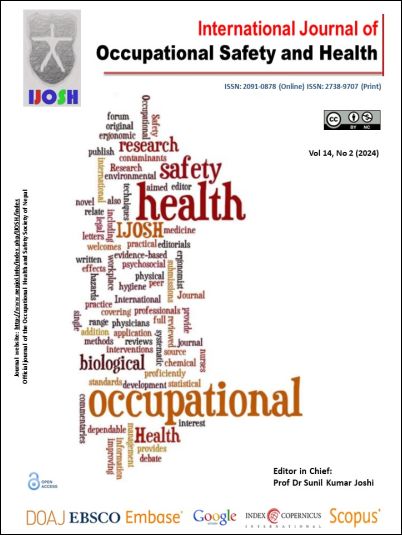Laboratory Risk Analysis in a Branch Hospital: The L-type Matrix
DOI:
https://doi.org/10.3126/ijosh.v14i2.53996Keywords:
Hospital, Laboratory, Occupational health and safety, Risk analysisAbstract
Introduction: Laboratory workers are often exposed to various risk factors, which can be classified as biological, physical, chemical, psychosocial, and ergonomic. This study aims to conduct a risk analysis in the workers of microbiology and biochemistry laboratories of a branch hospital in Istanbul, Türkiye to identify occupational health and safety risks and provide recommendations for measures to be taken.
Methods: The investigators conducted the risk analysis with a five-person team including occupational health and safety experts, a laboratory manager, and technicians. Risk assessments were performed using the L-type matrix 5x5 diagram. The level of risk was determined with the product of probability and severity.
Results: Risk analysis in the microbiology laboratory showed ten risk factors. Three of them had moderate level scores as following "working with xylene", “continuous standing work” and "insufficient free space". The remaining risks have low-risk scores, including "working in a noisy environment, "microscope light and ambient light", "working with blood", "working with feces", "non-ergonomic chairs", "insufficient airflow in the environment" and "continuous presence in a closed space". In the biochemistry laboratory, four were classified as moderate risk, including working in constant standing, exposure to bodily fluids, blood tests for bacteria and viruses and non-ergonomic furniture.
Conclusion: The priority should be to minimize the risks associated with contact with blood and body fluids. This could involve the implementation of strict safety measures and protocols, as well as providing appropriate personal protective equipment to all personnel who may encounter these fluids.
Downloads
Downloads
Published
How to Cite
Issue
Section
License
Copyright (c) 2024 The Author(s)

This work is licensed under a Creative Commons Attribution-NonCommercial 4.0 International License.
This license enables reusers to distribute, remix, adapt, and build upon the material in any medium or format for noncommercial purposes only, and only so long as attribution is given to the creator.





